This page is part of the HL7 FHIR Implementation Guide for Military Service History and Status (v0.1.0: STU 1 Ballot 1) based on FHIR (HL7® FHIR® Standard) R4. The current version which supersedes this version is 1.0.0. For a full list of available versions, see the Directory of published versions
The FHIR profiles and extensions in this implementation guide are intended to fill gaps in current implementations of HL7 Version 2 and RESTful APIs currently available to implementers. This implementation guide expands FHIR best practices to assist organizations that adapt and extend FHIR profiles and implementation guides required in their jurisdictions (e.g. US, Canada) to apply them to locally-applicable requirements that meet their stakeholders business needs. Currently there are several US Realm projects that need to use, manage, and collect information about military service, discharge, status, combat, etc. using information provided by patients/Veterans, validated based on service records. This project will help coordinate the effort to create profiles and extensions needed to represent Military Service History, Veteran status, and associated risk factors This specification also identifies code systems and terminology gaps that require require subsequent change proposals to LOINC and SNOMED CT consistent with the requirements summarized in the use cases.
This implementation guide design document is intended to create a set of profiles and extensions to support Military Service History and Status reporting consistent with US regulatory requirements (i.e. Title 38 Veteran Benefits) and extensible to other realms/jurisdictions (e.g. Canadian Forces). It harmonizes the requirements of the U.S. Department of Veterans Affairs (VA) and the Centers for Disease Control and Prevention (CDC) to record this information more easily in support of administrative and clinical workflows and the work and social history of patients who are also Veterans.
The use case anlaysis describes requirements and associated capabilities to manage and exchange information about Military Service History and Status. All requirements are analyzed as use cases involving actors/participants and system interactions.
Note: Certain requirements were discussed, deemed to be out-of-scope, and deferred (see Deferred Requirements).
Figure 1 is a summary of scenarios (use cases) representing the requirements for
recording self-reported military and combat history. It also illustrates how
FHIR-based APIs can be used to validate employment history information reported
by Veterans.
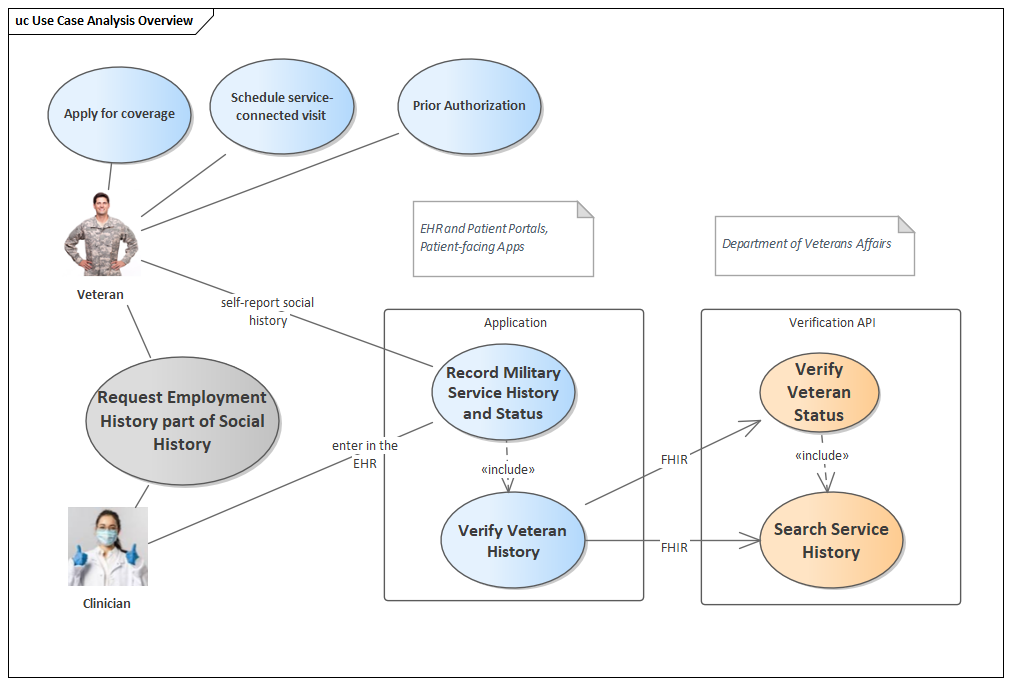 Figure 1: Use Case Analysis Overview
Figure 1: Use Case Analysis Overview
The clinician may be working with Veteran in the community and must assess the health risks associate with military service.
The Veteran is the focus of this specification. The API describe here allows Veterans to access and share their military service history and status information with community clinicians, community service agencies, vendors, and employers, etc. The Veteran can access their information or make it available to entities that assist Veterans. Military Service History may be combined with other employment history information.
This section describes the use cases needed to manage Military Service History both as self-reported employment history and API-supported verification of detailed military service history.
The clinician is requesting employment information in conjunction with their social history. If the patient is a Veteran, their employment history will include military service information. This was a core requirement of the Occupational Data for Heath (ODH) Implementation Guide we analyzed and reused. The current specification expands this use case to specify application (i.e. EHR) capabilities as well as reusable FHIR-based APIs that may be provided by an authoritative organization (e.g. US Department of Veterans Affairs).
The social history information reported by the patient - including employment and military service history - is entered in the system of record (i.e. EHR).
The EHR system, acting as a FHIR client, uses a standards-based VA RESTful API (FHIR Observation with profiles and extensions) to verify that the patient is a Veteran and served in the military.
The verification API is triggered by an EHR. Based on the verification result, the EHR may validate the Veteran status and fill in the combat episodes as needed to determine social history risks.
The Verification API proposed in this document determines the Veteran’s status by using demographic information submitted as a query (search operation) to a FHIR server that supports Observation resource - - using the Patient endpoint to determine whether a person is a verified veteran. Additional information is provided using the Search Service History criteria using the profiles described in the Information Requirements section (see Military Service Episode).
This use cases requires a cutom operation: Operation: $veteranStatus returns true if a patient is a Vetern, false otherwise, or an error if the search crieria do not match a patient record.
This use case is part of in the proposed verification API based on FHIR. If this search operation returns one or more Observation resources that conform Military Service Episode to the proposed profile, the Veteran’s status confirmed. If the search operation does not find any matching Observation resources, the Veteran’s status could not be confirmed.
The presence of one or more Observations that conform to the Deployment Episode profile proposed here indicates that Veteran served in combat.
The following use cases were discussed and deferred because they are out-of-scope for the profiles and extensions described in this implementation guide design document:
In HL7 Version 2 interfaces, the data required to exchange military service history and status is accomplished using extensions segments (i.e. Z-segments). The naming convention for extensions in HL7 Version 2 requires that new segment names start with the letter “Z”. For instance, the VA extension for “Military Service” is “ZMH”. This extension can be added to message payloads (e.g. administrative transactions) to convey this content. This section describes the result harmonizing requiremetns and prior experience with HL7 Version 2 and RESTful APIs used to convey military service history and status at this time. It also harmonizes the content of the Occupational Data for Health Implementation Guide developed by CDC to enhance social history and employment history reporting from EHR systems.
Figure 2 summarizes the proposed profiles and extensions needed to document military service history. The profiles described here constrain and extend the normative Observation resources profile (Release 4 and later) to ensure stability and reusability. FHIR Release 4 marked the first time some FHIR resources have attained normative status and will be maintained in a manner that ensure backwards-compatibility. Furthermore, using Observation R4 and later - rather than Basic resource - is the recommended approach to creating extensible APIs based on FHIR.
 Figure 2: Information Requirements
Figure 2: Information Requirements
Note: FHIR implementation, localization, and profiling best-practices are under development and evolving. This design document is intended to provide reasoning and context for future projects.
Employment history consists of a series Employment Episodes. In the past these episodes have been represented as Z-segments and added to various transactions to support social history determination, benefit, etc. This profile is intended to represent employment history for International use and it may be localized by HL7, IHE, and other profile developers.
The Employment Episode profile of is the base profile for Military Service Episode profile and ODH Past or Present Job profile and other profiles intended to describe specific types of employment.
This profile is marked as “constrainable” because it’s intended to be reused to create additional profile, more specific, or localized to jurisdiction.
| Data Elements | Multiplicity | Notes |
|---|---|---|
| id uuid | [1…1] | Unique identifier of the episode- typically assigned by a FHIR server. It may be used to retrieve a specific or latest version of the FHIR resource (i.e. Observation) used to represent military service episode(s) for a Veteran. Path: Oservation.id as globally/universally unique identifier (uuid) |
| url url | [1…1] | Profile canonical url used to reference this profile in an Observation that conforms this profile. Fixed value in the {StructureDefinition.url} to the value ‘http://hl7.org/fhir/StructureDefinition/employment-episode’ Path: Observation.meta.profile This profile may be used along with other profiles met by the Observation resource. |
| identifier Identifier | [0…1] | This data element may be used to specify a business identifier of the employment episode that could be referenced across FHIR APIs. Path: Observation.identifier |
| code CodeableConcept | [1…1] | Standard code that describes a generic employment episode using an extensible value set binding. This data element is mandatory (cannot be null) is this profile and any of its derivation. The value set binding is extensible but it requires a LOINC code. Path: Observation.code Binding strength: Extensible; to allow derived profiles to substitute the binding with a subset of the value set referenced here. Local temporary concept id: f6341bf2-e765-4639-8800-6805520ece8e The value set associated with this data element includes: 11341-5 (History of Occupation) 87511-2 (Combat zone AndOr hazardous duty work dates**)** extensible LOINC value set |
| startDate date | [0…1] | Data when the employment period started. This data element is optional in profile. Path: Observation.effectivePeriod.start |
| endDate date | [0…1] | End of employment date. if this employment episode is on-going, this data element is empty. Path: Observation.effectivePeriod.end Derived information: active employment episode if this data element is missing. A data-absent-reason extension may be used to clarify that the end of the period is not-applicable. |
| industry CodeableConcept | [0…1] | For this profile, this component/element contains the industry in which the patient was or is currently employed. This data element optional in this profile but it may be mandatory, required, or conditionally used in a derived profile. It may also be localized for required terminology in each realm. For example in the US, implementers are expected to use “Industry CDC NAICS 2012 (ODH)” (https://phinvads.cdc.gov/vads/ViewValueSet.action?id=571)(https://phinvads.cdc.gov/vads/ViewValueSet.action?id=5718C508-111B-4737-A48C-FDCFD301C0DF)8C508-111B-4737-A48C-FDCFD301C0DF” Path**: Observation.component.valueCodeableConcept** Binding strength: Preferred; to allow derived profiles to substitute the binding with a subset of the value set referenced here. The Observation.component.code is fixed to: 86188-0 (LOINC) |
| supervisoryLevel CodeableConcept | [0…1] | This data element corresponds to the Pay Grade associated with a military service episode. The value is intended to be a CodeableConcept. This data element may be localized to use a US-specific value set (e.g. “Supervisory Level or Pay Grade” : https://phinvads.cdc.gov/vads/ViewValueSet.action?oid=2.16.840.1.114222.4.11.7613) Path**: Observation.component.valueCodeableConcept** The Observation.component.code if fixed to: 87707-6 (LOINC). Binding strength: Preferred; to allow derived profiles to substitute the binding with a subset of the value set referenced here. |
| category CodeableConcept | [1…1] | Employment history is a part of the patient’s social history. Therefore this data element is fixed to “social-history”. This information in inherited by profiles derived from this constrainable profile. Path: Observation.category |
| occupation CodeableConcept | [0…1] | The occupation during the episode as a coded value. Path: Observation.valueCodeableConcept The recommended value set binding uses the CDC PHVS_Occupation_CDC_ONET-SOC2010_ODH https://phinvads.cdc.gov/vads/ViewValueSet.action?id=3ED71C35-8147-492B-B88F-94953573E55F (Occupation CDC ONET-SOC 2010 (ODH)) The recommended value set binding references the CDC PH_OccupationalDataForHealth_ODH code system: OID: 2.16.840.1.114222.4.5.327 Code System Name: Occupational Data for Health (ODH) Code System Code: PH_OccupationalDataForHealth_ODH Content: https://phinvads.cdc.gov/vads/ViewCodeSystem.action?id=2.16.840.1.114222.4.5.327 Binding strength: Preferred; to allow derived profiles to substitute the binding with a subset of the value set referenced here. |
The US Veteran profile specifies an additional extension to the set already supported by the FHIR US Core profile it extends.
| Operation | Notes |
|---|---|
| veteranStatus boolean | This extension is a boolean flag used to specify/store the confirmation/verification status. true: the Patient record describes a Veteran false: the Patient is either not a verified yet or under review if the flag is absent, then the veteran status is undetermined. |
This profile design describes how we use Observation resources to represent Military Service as a type of Employment History Episode.
A patient/Veteran may have zero or more military service episodes. The contents of this profile is based on the HL7 Version 2 ZMH segment and the ServiceHistoryEpisode schema specified in the current Veteran Verification API and it allows this API to migrate to FHIR and to be consistent with the prior work done by Center for Disease Control (CDC) National Institute for Occupational Safety and Health (NIOSH).
A service history episode may reference zero or more deployment episodes. This profile is based on the default FHIR Observation profile and The base profile is a newly defined Employment History Episeod abstract profile. This profile is similar ODH Past or Present Job profile. The major distinction from the ODH Is that Military Service History Episode does not require any information the job performed by the Veteran during their service.
The following is a list of constraints applied to Employment History Episode to describe military service episodes:
| Multiplicity | Notes | |
|---|---|---|
| url url | [1…1] | Profile canonical url used to reference this profile in an Observation that conforms this profile, http://hl7.org/fhir/us/StructureDefinition/ms-military-service-episode Path**: Observation.meta.profile** |
| code CodeableConcept | [1…1] | LOINC concept: to be defined - a member of “employment episode” value set. Path: Observation.code Constraints: Cardinality: [1,1] Local concept id (fixed): d3f8e4e1-874f-4ccc-b70e-76133b2e317d |
| startDate date | [1…1] | Start of military service episode. It is a mandatory data element for a valid military service episode. Path: Observation.effectivePeriod.start Constraints: Cardinality: [1,1] |
| endDate date | [0…1] | End of military service episode date. It must be specified (mandatory) for any valid military service episode. Path: Observation.effectivePeriod.end Constraints: Cardinality: [1,1] |
| industry MilitaryBranchCode | [1…1] | For this profile, this component/element contains the branch military or a code indicating national guard or reserve. “Branch of military including National Guard or Reserve status.” The CDC OMB 2010 (or 2020) Industry concepts are sufficient to describe the Military Branch including “National Guard or Reserve” - as a single concept. These US-specific concept will be added to the SNOMED CT US extension maintained by NLM. Based on feedback from VA implementers, it’ snot necessary to distinguish “reserve” from “national guard” service. This profile will use a subset of Industry concepts related to military service. Constraints: Cardinality: [1,1] Value set binding for component.valueCodedConcept: Military Branch Code Binding strength: required; to enforce the use of the value set. LOINC code: 86188-0 reused from ODH |
| dischargeStatus DischargeStatusCode | [0…1] | For this profile, the data element specifies to “discharge status” described as “Character of discharge from service episode.” This data element is mandatory for service history reported by the VA but it may be empty if the patient is still active military. Path: Observation.component (code: to be added to LOINC). See Logica Solor page: https://logica.atlassian.net/wiki/spaces/SOLOR/pages/865271876/Military+Service+History+and+Status Constraints: Cardinality: [1,1] Value set binding for component.valueCodedConcept: DischargeStatusCode Binding strength: required; to enforce the use of the value set. Local concept id: 836df973-002b-4bb6-9eca-83626af0c05c |
| supervisoryLevel PayGradeCode | [1…1] | This data element corresponds to the Pay Grade associated with a military service episode. Constraints: Cardinality: [1,1] Value set binding for component.valueCodedConcept: PayGradeCode Binding strength: required; to enforce the use of the value set. Fixed Value: 87707-6 (Supervisory Level) |
| separationReason SeparationReasonCode | [0…1] | Additional text description for separation reason beyond discharge status value. It’s an optional, coded data element (see SeparationReasonCode for a list of proposed concepts to be added to SNOMED CT). Path: Observation.component (code: to be added to LOINC). See Logica Solor page: https://logica.atlassian.net/wiki/spaces/SOLOR/pages/865271876/Military+Service+History+and+Status Constraints: Cardinality: [1,1] Value set binding for component.valueCodedConcept: SeparationReasonCode Binding strength: required; to enforce the use of the value set. Local concept it: 066ccc24-04d1-4c58-a2cf-abe2e722d1a3 |
This profile definition similar to Combat Zone Period profile (url: http://hl7.org/fhir/us/odh/StructureDefinition/odh-CombatZonePeriod ) and includes the requirements specified in ZMH and Deployment Schema.
The base profile reuses the pattern Combat Zone Period profile and adds new components. However, since it’s intended to share “deployment” information this profile is more generic that the specifics ODH.
| Multiplicity | Notes | |
|---|---|---|
| url url | [1…1] | Proposed canonical URL for this profile: http://hl7.org/fhir/us/odh/StructureDefinition/ms-combat-episode |
| id uuid | [1…1] | Unique identifier of the episode. It may be used to retrieve a specific or latest version of the FHIR resource (i.e. Observation) used to represent combat episode(s) for a Veteran. The guidance to implementers is to use an auto-generated UUID rather than a long integer. Both options are supposed by the FHIR base standard by open-source FHIR server implementations (e.g. HAPI). |
| code CodeableConcept | “deployment” [1…1] | LOINC concept based on the value set : deployment training humanitarian/disaster relieve combat/war time “deployment” |
| startDate | [1…1] | The start date for combat episode; it must be specified for all combat episodes. Path: Observation.effectivePeriod.start Constraints: Cardinality: [1,1] |
| endDate | [1…1] | The end date of the combat episode must be specified if this profile is used to specify historical data. Path: Observation.effectivePeriod.end Constraints: Cardinality: [1,1] Mandatory |
| country CountryCode | [1…1] | This data element is an additional component to the base profile. It’s intended to specify the country where the deployment occurred. Constraints: Cardinality: [1,1] Mandatory Path**: Observation.component.valueCodeableConcept** The Observation.component.code is fixed to: a concept (LOINC) See resolution at: https://logica.atlassian.net/wiki/spaces/SOLOR/pages/865271876/Military+Service+History+and+Status Local concept id for “Country of Deployment”: b18ae858-d1dd-4edb-89f2-b9835f2eba1e |
| mission MissionCode | [0…1] | This data element corresponds to “military service history type” (e.g. Persian Gulf, Operation Iraqi/Enduring Freedom) in addition to locale-based (e.g. Somalia, Lebanon, Grenada, Yugoslavia, Panama). Additional questions re: combat episodes: Do we need to identify POW status re: combat episode? Is the d the “service component” necessary (e.g. regular, activated reserve, activated national guard)? |
| category CodeableConcept | [1…1] | “social-history” - fixed value fort this profile. |
The profile reuses the ODH PastOrPresentJob profile to apply it specifically to military jobs/occupations. One or more military occupations may be referenced by a single Military Service History record. This profile uses a subset of data elements as seen below:
| Multiplicity | Notes | |
|---|---|---|
| startDate. date | [1…1] | Start of military service episode. It is a mandatory data element for a valid military service episode. Path: Observation.effectivePeriod.start Constraints: Cardinality: [1,1] |
| endDate. date | [0…1] | End of military service episode date. It must be specified (mandatory) for any valid military service episode. Path: Observation.effectivePeriod.end Constraints: Cardinality: [1,1] |
| code CodeableConcept | LN:Extension [1…1] | LOINC concept: to be defined - a member of “employment episode” value set. Path: Observation.code Constraints: Cardinality: [1,1] |
| occupation CodeableConcept | [0…1] | The occupation during the military service episode as a coded value. Note: This data element his is not currently supported by the VA API, it would be an enhancement in the FHIR-based API Path: Observation.valueCodeableConcept) The recommended value set binding references is to a subset of occupations based on the Military Occupation Code taxonomy maintained by the Department of Defense. Proposed value set name: military-occupation; the value set will be based on “Occupation CDC ONET-SOC 2010 (ODH)”: https://phinvads.cdc.gov/vads/ViewValueSet.action?id=3ED71C35-8147-492B-B88F-94953573E55F The occupation taxonomy/code can be used by clinicians to assess health risks of musculoskeletal disorders, heart disease, behavioral health, and hazardous chemical exposures. |
| url. url | [1…1] | Profile canonical url used to reference this profile in an Observation that conforms this profile, http://hl7.org/fhir/us/StructureDefinition/ms-military-service-episode Path**: Observation.meta.profile** |
ISO 3166 country code.
A SNOMED CT concept (Observation.component.value) that describe additional information about combat, mission, other criteria. This data element may be elaborated along multiple components.
An initial gap analysis of SNOMED CT terminology identified that we are missing significant content related to discharge status requirements in DischargeStatusCode.
Other terminology extension and harmonization targets are:
Another gap is “separation reason” that requires a coded concept for its Observation component and its allowed values.
In the future, the Mission Code may also need a SNOMED CT extension if the VA API requires it.
For a complete set of terminology extension, refer to the Logica Solor page intended to address the concept gaps: https://logica.atlassian.net/wiki/spaces/SOLOR/pages/865271876/Military+Service+History+and+Status
The following diagram summarizes the terminology requirements for this implementation guide.This analysis is further refined as a Logica Health Solor activity:
https://logica.atlassian.net/wiki/spaces/SOLOR/pages/865271876/Military+Service+History+and+Status
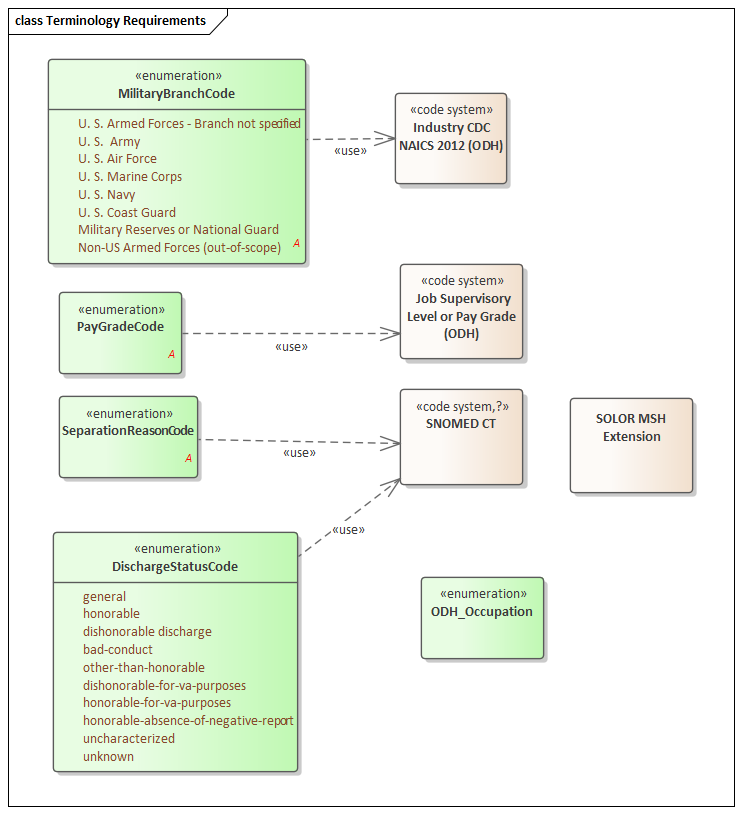
Figure 3: Terminology Requirements
This code system is used in value set:” Job Supervisory Level or Pay Grade (ODH)”
https://phinvads.cdc.gov/vads/ViewValueSet.action?id=B35E2ABE-C20F-EA11-8183-005056ABE2F0
This code system used in value set Military Branch Code
Code system url: Currently the code system URL will be the one published by the UT project.
SNOMED CT will be used to fill any terminology gaps that are not already addressed by FDA code systems in the US.
A code system representing the SOLOR extension for Military Service History and Status in Logica Health.
The extension for this IG addresses the following gaps: https://logica.atlassian.net/wiki/spaces/SOLOR/pages/865271876/Military+Service+History+and+Status
The proposed canonical URL is:https://www.logicahealth.org/solutions/solor/military-service
Reference issue: “ https://jira.hl7.org/browse/FHIR-27926?filter=-2
https://phinvads.cdc.gov/vads/ViewValueSet.action?id=5718C508-111B-4737-A48C-FDCFD301C0D
Value Set Name: Industry NAICS Detail (ODH)
Value Set OID 2.16.840.1.114222.4.11.7900
Value Set Description Concepts describing the kind of business that compensates the person for work (e.g., wages, training) or assigns work to a volunteer, as reported by the person. The kind of business is determined based on the primary business activity conducted by the company, organization, or individual (for those who are self-employed), or, for a military position, the self-reported branch of service. The value set was created by coding the NAICS index terms, which are relatable to the general public, to facilitate collection and validation by patients. A downloadable file available from the PHIN VADS ODH Hot Topics section is structured to support computer-assisted searching of this value set. The file also contains a crosswalk from the concepts in this value set to Occupation_CDC_Census value set concepts.
A SNOMED CT Extension needed to describe the status when an individual leaves military service.
The VA API and Z-segment specification declares local extensions to SNOMED CT corresponding to subtypes of “Left Military Service” 266964007 concept.
Question: Should it include “active” because we may have a DoD API that works in a similar way?
Answer: No, the cardinality should allow for this data element to omitted if the service episode is the current episode.
| Description | |
|---|---|
| general | General status. This concept is a gap in SNOMED CT. subtype of “Left Military Service” 266964007 concept. local concept id: |
| honorable | Additional description pending.] This concept is a gap in SNOMED CT. |
| dishonorable discharge | This status has an equivalent concept in SNOMED CT: 276086007 |
| bad-conduct | This concept is a gap in SNOMED CT. |
| other-than-honorable | This concept is a gap in SNOMED CT. Relationships: This concept has two child concepts: honorable-for-va-purposes dishonorable-for-va-purposes During the review process, the Veteran will in “Pending Character of Discharge” (COD) state defined as “ |
| dishonorable-for-va-purposes | This status is obtained when “other-than-honorable” is later deemed to be dishonorable for Title 38 Veteran Benefits criteria. This concept is a gap in SNOMED CT. “Has a Character of Discharge (COD) review from VBA ruling the individual Dishonorable for VA Purposes (DVA), and was originally one of the discharge types in the second row of this table.” Relationships: This concept is a subtypes of “Other-than-honorable” . |
| honorable-for-va-purposes | This status is obtained when “other-than-honorable” is later deemed to be honorable for Title 38 Veteran Benefits criteria. This concept is a gap in SNOMED CT. “Has a character of discharge of: • Honorable • Under Honorable Conditions (General) • Uncharacterized (Entry level separation) OR Has a Character of Discharge (COD) review from VBA ruling the individual Honorable for VA Purposes (HVA).” Relationships: This concept is a subtypes of “Other-than-honorable” |
| honorable-absence-of-negative-report | This concept is a gap in SNOMED CT. Relationships: This concept is a subtype of “honorable-discharge ?” |
| uncharacterized | This concept is a gap in SNOMED CT. |
| unknown | This concept is a gap in SNOMED CT. Missing information about discharge status. |
“The military branch associated with service, National guard, and Reserve.”
The Military Branches coded concepts are documented in PHIN VADS as Industry CDC NAICS 2012 (ODH).
Localization Note:
From an occupational standpoint, any foreign military service should be captured as well as US military service. The profile allows an “extensible” terminology binding to allow a service history that includes service in US and foreign armed forces.
The VA API will be limited to US Armed Forces; similarly, Canadian Forces will implement a realm-specific approach that accommodates Canadian requirements.
Note: the following is complete list of concepts to describe the military branch.
Additional: NOAA and Merchant Marine members may also be included in this value set.
| Description | |
|---|---|
| U. S. Armed Forces - Branch not specified | Code: 9870: Military Reserves or National Guard System URL: http://terminology.hl7.org/CodeSystem/PHIndustryCDCCensus2010 |
| U. S. Army | Code: 9670 (U.S. Army) System URL: http://terminology.hl7.org/CodeSystem/PHIndustryCDCCensus2010 |
| U. S. Air Force | Code: 9680: U.S. Air Force System URL: http://terminology.hl7.org/CodeSystem/PHIndustryCDCCensus2010 |
| U. S. Marine Corps | Code: 9770 (U.S. Marines) System URL: http://terminology.hl7.org/CodeSystem/PHIndustryCDCCensus2010 |
| U. S. Navy | Code: 9690: U.S. Navy System URL: http://terminology.hl7.org/CodeSystem/PHIndustryCDCCensus2010 |
| U. S. Coast Guard | Code: 9780: U.S. Coast Guard System URL: http://terminology.hl7.org/CodeSystem/PHIndustryCDCCensus2010 |
| Military Reserves or National Guard | Concept (id: 9870] is used to specify Reserves or National Guard service. Code: 9870: Military Reserves or National Guard System URL: http://terminology.hl7.org/CodeSystem/PHIndustryCDCCensus2010 |
| Non-US Armed Forces (out-of-scope) | This concept is out of scope but it was discussed as potential requirement. This concept is out-of-scope at this time. |
Defines the level of compensation for a position, normalized across military branches. This value set harmonizes the concepts used in VA wit those specified by FDA for Occupational Data for Health implementations.
This specification will use the latest FDA value set specified in Job Supervisory Level or Pay Grade.
“Additional description for separation reason beyond discharge status value.”
Note: This may need to be specified as a code value rather than a text value.
Separation reason codes. These codes will be addressed as gaps/change requests in SNOMED CT using the Solor Project: https://logica.atlassian.net/wiki/spaces/SOLOR/pages/865271876/Military+Service+History+and+Status
One of the requirements of this implementation guide is to provide an operation for to confirm or verify that an individual has been confirmed to be a veteran.
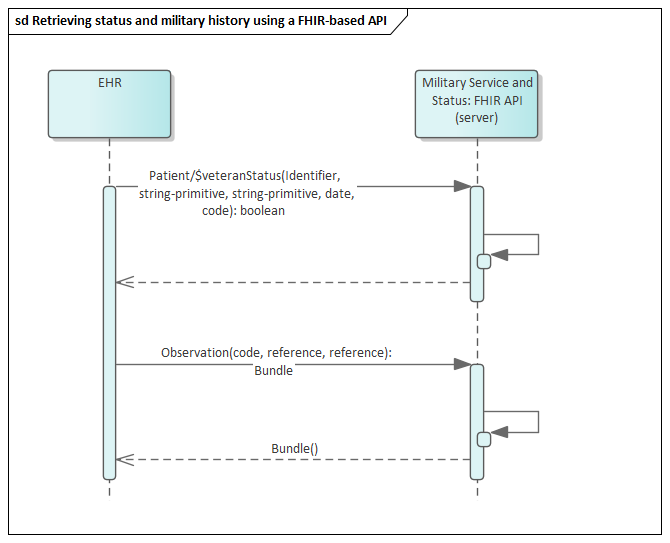 Figure 5: Retrieving status and military history using a FHIR-based API
Figure 5: Retrieving status and military history using a FHIR-based API
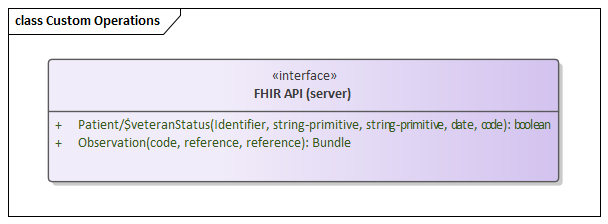 Figure 6: Custom Operations
Figure 6: Custom Operations
The following represents the proposed API. It relies on a custom operation ($veteranStatus) associated with the Patient resource and Observation resources to represent the military service history episode including deployment and occupation:
This API specifies the resources and operations required in an API that meets the requirements specified in the Use Case Analysis:
Patient/$veteranStatus with parameters: last name, first name, gender, date of birth, social security number.
Patient resource needed to retrieve the id of the resources matching a verified veteran.
Observation resource to manage the information associated with military service and veteran status.
### Transactions
#### Patient/$veteranStatus()
| This operation provides verification and confirmation of a Patient’s status as a Veteran based on the identifying traits. This operations addresses both the “verification” and “confirmation” capabilities currently available to application developers who use the VA Developer API “Veteran Verification” endpoint. This operation returns a true, if the patient is confirmed to be a Veteran, false if the patient is not validated/confirmed to be Veteran. Error 404 will specify that the patient could not be found. The client system may resubmit the operation with revised parameter or interpret the error to indicate that the Veteran status of an individual could not be confirmed or validated using the API. This operation implements the Verify Veteran Status use case described in the Use Case Analysis section. |
| Note: This operation has a dependency on the implementation of a Patient resource that supports the capability to record that a Patient’s veteran status was confirmed. ||
| [IN] firstName Patient’s first name, mandatory string-primitive |
| [IN] gender Patients gender - as specified in the Administrative Gender value set. |
|### Observation** search The Military Service Episode , Deployment Episode, and Military Occupation are all profiles of Observation resource and using a subset of available parameters for Observation resource):
| A search operation that uses the search parameters described here meets the requirements specified in Use Case Analysis : Search Service History use case. Note: the “code” values corresponding to Military Service Episode , Deployment Episode, and Military Occupation will be submitted to post the ballot. | code This parameter would be set to the LOINC code associated with Military Service and/or Deployment History, reference, has-member This parameter set to the Military Occupation and/or Combat History reference ] patient |
To record the confirmed Veteran status, this IG has identified the need to specify an extension on the Patient to specify whether the patient was confirmed to be a veteran. The US Vetrean profile extends the US Core Patient profile and adds the “vetaranStatus” data element as a true/false (boolean). If pilot projects need it, this extension can be revised to support a state machine for Veteran determination (e.g. submitted –> under verification –> verified: eligible/ineligible/not a Veteran)
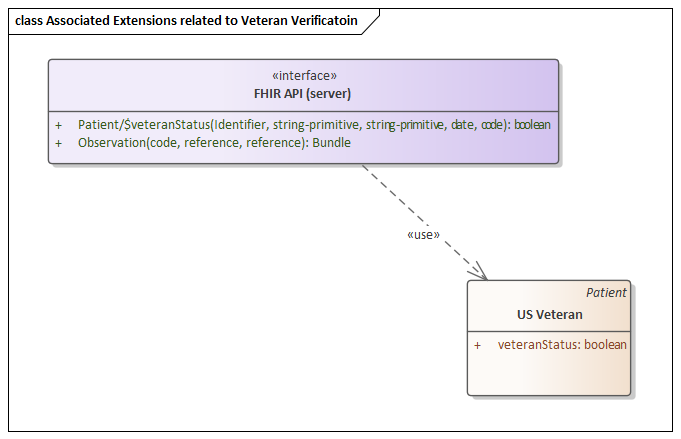 Figure 6: Associated Extensions related to Veteran Verification
Figure 6: Associated Extensions related to Veteran Verification
The current VA API uses an ad-hoc verification operation and allows third-party systems to retrieve the military service - including combat episodes. This track will demonstrate how this API can be provided using a standards-based approach that includes FHIR resources and terminology constraints using concepts from LOINC, SNOMED CT, and CDC ODH - as specified in the associated Logica project intended to validate the extensions needed to represent Military Service and Combat Episodes using Observation resource similar to ODH. The current REST API is used primarily verify veteran status for benefits associated with military service (e.g., insurance coverage, discounts, education assistance, etc.). The enhanced FHIR-based API will make this API readily available for health-related purposes: social determinants of health, risk factors for specific conditions (e.g. health disease, major depressive disorder, suicidal ideation).
In addition to proving the feasibility of FHIR resources to provide equivalent capabilities to the current API, this project will also introduce standards-based concepts in place of local VA terminology for discharge status and separation reason as well we reusing CDC ODH concept to represent the military branch and pay grade of a Veteran.
This workflow identifies the activities and API calls required to address the requirements specified in the Use Case Analysis. Successful testing may also use test scripts and pre-conditions to results of an EHR invoking the proposed API to verify status and retrieve the military history information of a Veteran using FHIR-based resources. This diagram uses Object Management Group’s (OMG) Business Process Modeling Notation (BPMN) to describe the pre-conditions/triggers and post-conditions/results of using the FHIR-based API outlined in this implementation guide:
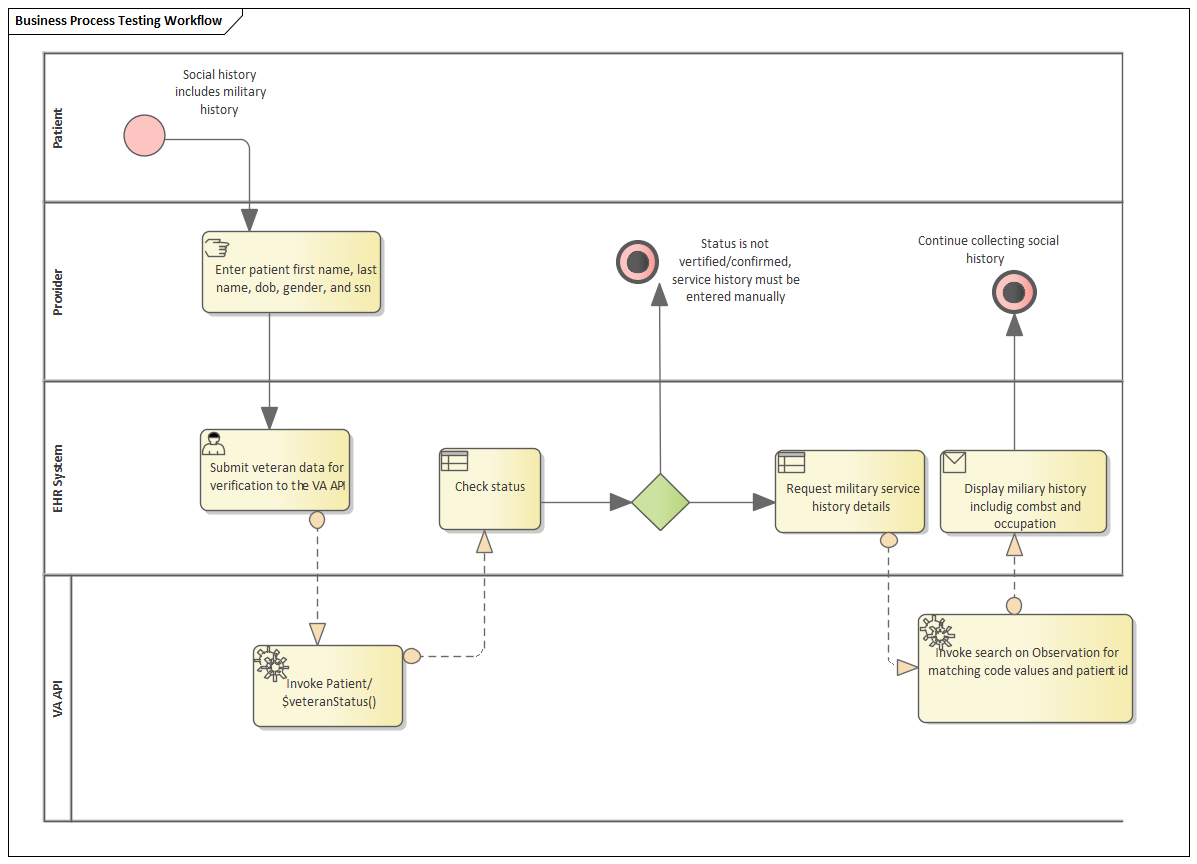 Figure 7: Testing Workflow
Figure 7: Testing Workflow
Scenario #1: Veteran Confirmation and Verification
A Veteran is receiving treatment in the community and invokes the “$veteranStatus” operation using the Veteran’s demographics (e.g. fist, last, date of birth, social security number). If the Veteran is verified then the client application proceed to Step 2.
Scenario Step 1 : Search the Patient resource to evaluate whether “Sam Share” is a confirmed/validated Veteran based on the VA-specific extension
Scenario Step 2: Search the Observation resource for a list of Military Service Episodes: search by “subject” (i.e. Patient/Veteran) and by “patient” and “code” search parameters
For more details on testing, you may refer to the FHIR Connectathon 25 (September 2020) Track for Military Service History and Status.
Example Patient and Observation resources conforming to this IG are available in this publication under Examples.
This implementation guide builds upon existing FHIR implementation guidance and best practices:
The project team would like to thank our leadership and colleagues for their support in the development of Application Programming Interface (API) implementation guide:
Department of Veterans Affairs:
Work Group Co-chairs:
Project team:
VA Developer API (Lighthouse Project):
Defense Health Agency:
CDC NIOSH:
MITRE:
ESAC
ALTARUM